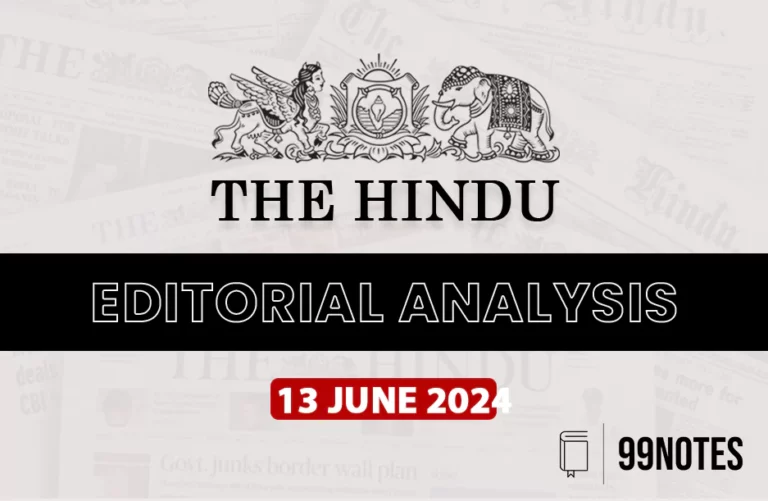28 July 2023 : The Hindu Editorial Notes PDF
The Hindu Editorial
28-July-2023
Daily Current Affairs For UPSC ,The Hindu Editorial Summary
1. Weighing in on the National Research Foundation Bill.
Topic: GS2 – Indian polity.
Context:
- The Union Cabinet approved the National Research Foundation (NRF) Bill 2023 in June to strengthen the research ecosystem in India.
- The Bill aims to establish an apex body for research and development, fostering innovation and nurturing a research ecosystem in universities and colleges.
Key provisions National Research Foundation Bill:
- Establishment of the National Research Foundation (NRF): The NRF would be an apex body to promote research and development in India. It would be responsible for providing strategic direction to research and development, coordinating research activities across different government agencies and departments, and promoting international collaboration in research.
- Funding of research projects: The NRF would be responsible for funding research projectsin a variety of fields, including science, engineering, technology, social sciences, and humanities.
- Governance of the NRF: The NRF would begoverned by a Governing Board consisting of eminent researchers and professionals from across disciplines.
- Corpus fund: The NRF would have a corpus fund of Rs. 50,000 crore, of which 14,000 crore would be contributed by the central government and the remaining Rs. 36,000 crore would be raised from the private sector.
- Repeal of the Science and Engineering Research Board (SERB):The bill proposes to repeal the Science and Engineering Research Board (SERB), a statutory body that was established in 2008 to promote basic research in Science and Engineering.
Significance of National Research Foundation Bill:
- The NRF would help to identify and address national priorities in research: The NRF would be able to assess the country’s needs and priorities in research, and would be able to allocate resources accordingly.
- The NRF would help to promote interdisciplinary research:The NRF would be able to bring together researchers from different disciplines to work on common problems. This would help to break down silos and would lead to new and innovative solutions.
- The NRF would help to attract and retain top talent in India: The NRF would be able to offer competitive salaries and benefits to researchers. This would help to attract top talent from India and abroad, and would help to build a strong research and development ecosystem in the country.
Concerns raised over National Research Foundation Bill:
- The lack of transparency in the selection process for the Governing Board: The bill does not specify how the members of the Governing Board will be selected. This has led to concerns that the board may be dominated by government officials and that there will be no independent oversight of the NRF.
- The lack of clarity on the NRF’s role in setting research priorities: The bill does not specify how the NRF will set research priorities.This has led to concerns that the NRF will be too focused on meeting the government’s short-term political goals, rather than on supporting long-term research that is important for the country’s development.
- The lack of clarity on the NRF’s relationship with other research funding agencies: The bill does not specify how the NRF will interact with other research funding agencies, such as the Department of Science and Technology and the Department of Biotechnology. This has led to concerns that the NRF will duplicate the work of these agencies, or that it will fail to coordinate its activities with them.
Model question: What is the National Research Foundation (NRF), and what are the concerns raised by the scientific community regarding its proposed budgetary allocation? Suggest measures to enhance research funding and promote innovation in India.
2. The hornets’ nests in the Forest Amendment Bill
Topic: GS2 – Indian polity.
Context:
- The Lok Sabha passed the Forest (Conservation) Amendment Bill, 2023, on July 26, without significant changes from the original version introduced in March.
- The Forest (Conservation) Amendment Bill, 2023 aims to amend the Forest Conservation Act of 1980, which had a protectionist stance on forest clearances.
Key provisions of Forest Amendment Bill:
- The bill defines “forest” as an area of land predominantly covered with trees and under the government’s control.
- It allows de-reservation of forests for purposes like national security, infrastructure, and industrial development.
- Forest land can be used for non-forest purposes with the Central Government’s approval, such as roads, railways, industries, and horticultural crops.
- The bill permits the assignment of forest land to private entities for afforestation, eco-tourism, and infrastructure development.
- Compensatory afforestation is required for any forest land diverted for non-forest purposes, with the amount determined by the Central Government.
- Non-compliance with the bill may lead to imprisonment of up to five years and/or a fine of up to Rs. 50 lakh.
The Problem areas:
- Concerns have been raised by environmental experts about three key points in the Bill:
- Narrowed definition of forests under its scope, excluding significant forest areas and granting sanction to additional activities that were regulated earlier.
- Restricting the application of the landmark Godavarman judgment, potentially impacting around 28% of India’s forest cover, including forests of exceptional conservation value.
- Excluding fragile ecosystems, such as biodiversity hotspots in northeastern India and Himalayan forests and meadows, from the need for forest clearances for security-related infrastructure.
Exclusion of indigenous communities:
- The Forest (Conservation) Amendment Bill, 2023 does not mention other relevant forest laws, including the Scheduled Tribes and Other Traditional Forest-dwellers (Recognition of Forest Rights) Act, 2006.
- The exclusion and ease of diversion of forest areas under the Bill will result in forest people’s institutions no longer needing to be consulted.
- This exclusion of forest communities could impact equity and participation in forest conservation efforts.
Conclusion:
- While exceptions for fast-tracking strategic and security-related projects are justified, blanket exemptions from regulatory laws are not a suitable solution.
- India’s natural ecosystems, especially in the geologically active Himalayan region, need proper geological and environmental assessments for all development projects to avoid potential disasters like the recent events in Joshimath, Uttarakhand.
Model question: Explain the key provisions of the Forest (Conservation) Amendment Bill, 2023, and discuss its implications for forest conservation and environmental protection in India.
3. Elusive consensus: On transparency and the state of India-China ties.
Topic: GS2 – International relations.
Context:
- India and China’s recent high-level engagement resulted in sharply different diagnoses of their relations.
- National Security Adviser Ajit Doval highlighted India’s concerns about the situation along the Line of Actual Control (LAC) and emphasized the need to restore peace and tranquillity in the border areas.
China and India’s stand:
- China’s readout emphasized the big picture, calling for an early return of ties to healthy and stable development and referenced a claimed “Bali consensus” reached by Prime Minister Narendra Modi and President Xi.
- The Modi government needs to be more transparent in laying out the state of relations with China, especially along the border, as opacity and defensiveness have marked its responses.
Increasing concerns about relationship between two countries:
- Contradictions exist in the government’s approach, with a welcome to Chinese investment in certain sectors but also banning more than 200 Chinese apps.
- Little clarity remains on the LAC situation and continuing ingresses by China in Demchok and Depsang.
- While arrangements to set up buffer zones in some points are in place, the terms and withdrawals by both sides remain undisclosed.
Conclusion:
- In conclusion, the contrasting diagnoses of India-China relations highlight the need for greater transparency and clarity in the government’s approach.
- As tensions persist along the border and complexities arise in trade and investment dynamics, open communication with the public is essential for navigating this critical bilateral relationship effectively.
For Enquiry

28 July 2023 : The Hindu Editorial Notes PDF

28 July 2023 : Daily Current Affairs

27 July 2023 : Daily Quiz

27 July 2023 : PIB

27 July 2023 : The Hindu Editorial Notes PDF

27 July 2023 : Daily Current Affairs

26 July 2023 : Daily Quiz

25 July 2023 : Daily Quiz

26 July 2023 : The Hindu Editorial Notes PDF

26 July 2023 : PIB
The Hindu 28 July 2023 : The Hindu Editorial Notes PDF The Hindu Editorial
27-July-2023
Daily Current Affairs For UPSC ,The Hindu Editorial Summary
Facebook-f
Twitter
Youtube
1. Shedding…
Daily Current Affairs 28 July 2023 : Daily Current Affairs DAILY CURRENT AFFAIRS
Daily Current Affairs For UPSC ,Daily Current affairs of The hIndu and Indian Express.
28-July-2023
Facebook-f
Twitter
Youtube
1. G-20:…
Daily Quiz 27 July 2023 : Daily Quiz 27 July 2023 : Daily Quiz…
PIB 27 July 2023 : PIB PRESS INFORMATION BUREAU
27-July-2023
Daily Current Affairs For UPSC ,The PIB ( Press Information Bureau…
The Hindu 27 July 2023 : The Hindu Editorial Notes PDF The Hindu Editorial
27-July-2023
Daily Current Affairs For UPSC ,The Hindu Editorial Summary
Facebook-f
Twitter
Youtube
1. Shedding…
Daily Current Affairs 27 July 2023 : Daily Current Affairs DAILY CURRENT AFFAIRS
Daily Current Affairs For UPSC ,Daily Current affairs of The hIndu and Indian Express.
27-July-2023
Facebook-f
Twitter
Youtube
1. No-trust…
Daily Quiz 26 July 2023 : Daily Quiz 26 July 2023 : Daily Quiz…
Daily Quiz 25 July 2023 : Daily Quiz 25 July 2023 : Daily Quiz…
The Hindu 26 July 2023 : The Hindu Editorial Notes PDF The Hindu Editorial
26-July-2023
Daily Current Affairs For UPSC ,The Hindu Editorial Summary
Facebook-f
Twitter
Youtube
1. Moving…
PIB 26 July 2023 : PIB PRESS INFORMATION BUREAU
26-July-2023
Daily Current Affairs For UPSC ,The PIB ( Press Information Bureau…


